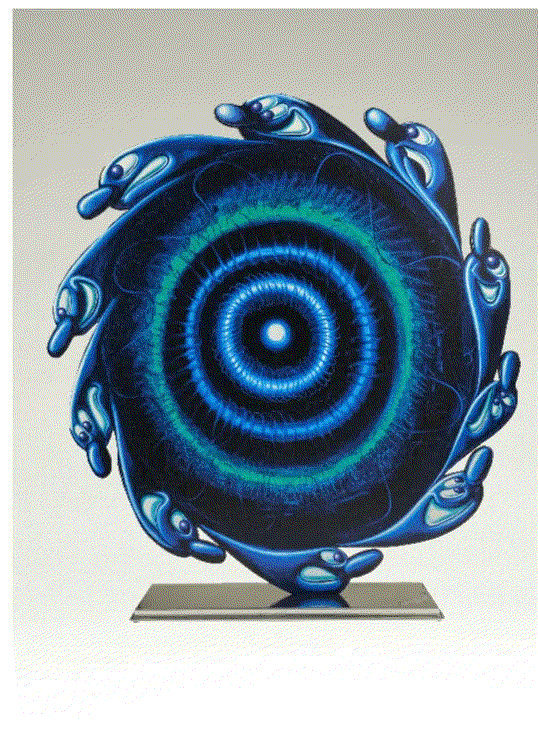Tom Wesselmann
-
 Tom WesselmannSeascape, 1998Mixografía® print on handmade paper28 1/2 x 60 in
Tom WesselmannSeascape, 1998Mixografía® print on handmade paper28 1/2 x 60 in
72.4 x 152.4 cmEdition of 50signed and dated in pencil -
 Tom WesselmannMixed Bouquet with Leger, 1993Screenprint on museum board54 1/2 x 51 2/8 ins 138.43 x 130.18 cm
Tom WesselmannMixed Bouquet with Leger, 1993Screenprint on museum board54 1/2 x 51 2/8 ins 138.43 x 130.18 cm -
 Tom WesselmannStill life with Lichtenstein and Two oranges, 1993Screenprint on 100% rag 4-ply Museum board42.5 x 59Edition of 90Signed in pencil by the artist and Dated
Tom WesselmannStill life with Lichtenstein and Two oranges, 1993Screenprint on 100% rag 4-ply Museum board42.5 x 59Edition of 90Signed in pencil by the artist and Dated -
 Tom WesselmannStill Life with Liz (WPI P9227), 1993Silkscreen59 1/2 x 57 in
Tom WesselmannStill Life with Liz (WPI P9227), 1993Silkscreen59 1/2 x 57 in
151.1 x 144.8 cm44/90Signed and numbered in Pencil -
 Tom WesselmannMaquette for Still Life with Johns and Matisse, 1991Liquitex on Bristol board18 x 22 x 4 ins 45.72 x 55.88 x 10.16 cmSigned and dated on the bottom of the image
Tom WesselmannMaquette for Still Life with Johns and Matisse, 1991Liquitex on Bristol board18 x 22 x 4 ins 45.72 x 55.88 x 10.16 cmSigned and dated on the bottom of the image -
 Tom WesselmannNude with Bouquet and Stockings, 1991Silkscreen44 1/2 x 80 ins 113.03 x 203.2 cm
Tom WesselmannNude with Bouquet and Stockings, 1991Silkscreen44 1/2 x 80 ins 113.03 x 203.2 cm -
 Tom WesselmannStudy for Seascape with Cumulus Clouds and Sky, 1991Pencil and Liquitex on Bristol Board11 x 23 ins 27.94 x 58.42 cm
Tom WesselmannStudy for Seascape with Cumulus Clouds and Sky, 1991Pencil and Liquitex on Bristol Board11 x 23 ins 27.94 x 58.42 cm -
 Tom WesselmannLUlu, 1982lithograph in colors22 x 30 inEdition of 250Signed, dated and numbered to lower right ‘Wesselmann 82
Tom WesselmannLUlu, 1982lithograph in colors22 x 30 inEdition of 250Signed, dated and numbered to lower right ‘Wesselmann 82 -
 Tom WesselmannSmoker, 1976Screenprint in colors on Museum Board26 x 19.5Edition VII/LHand signed and dated in pencil
Tom WesselmannSmoker, 1976Screenprint in colors on Museum Board26 x 19.5Edition VII/LHand signed and dated in pencil
The mainstream media like to think Andy Warhol was the predominate and most successful of the pop art influencers. But there was someone else whose imagery and use of block colors helped really identify the pop art movement of the 1950s and 1960s – mostly through his “action art” paintings of young women and still life paintings. Tom Wesselmann is as much a part of the pop art movement as Warhol and his paintings continue to inspire and provoke emotions to this day.
Born in 1931 in Cincinnati, Ohio, Tom Wesselmann first went to school at the University of Cincinnati before eventually joining the military between 1951 and 1954. However, it was during his time with the army that Wesselmann began to draw cartoons and other sketches to pass the time while on tour and duty, which then progressed into something that he wanted to turn into a career after his time was done with the military. After his tour of two years ended, Tom Wesselmann was soon accepted into the Art Academy of Cincinnati and graduated with his degree only to head back to college for another degree at Cooper Union in New York.
During most of his time through university, he remained to mostly do sketches and simplistic looking illustrations. However, Cooper Union professors and other faculty alike kept encouraging and exposing Tom Wesselmann to painting and printmaking. It would be this sort of “peer pressure” that would help Wesselmann to start creating collages, paintings, and assemblages in the early 1960s, right when the pop art movement was starting to really ignite. Much like Andy Warhol, Tom Wesselmann took imagery from popular culture, magazines, consumer goods, and advertisements to incorporate into his own paintings, which help him establish his name within the pop art community quickly.
It wouldn’t be until the late 1960s that he would move from advertisements and popular culture references to more sexually styled paintings of women in the nude. This would spark his very controversial and highly praised pieces known collectively as the Great American Nudes. Tom Wesselmann didn’t do the simple figure of a woman’s body, however. They would be simply drawn and painted, with major highlights going toward the figure, hair, breasts, and lips of the anonymous woman. There are many paintings he did of naked women that have no facial features that are just simply silhouettes.
Going into the 1970s, Tom Wesselmann would begin experimenting and expanding into other mediums, such as his shaped canvas still life paintings part of his Standing Still Life collection and using materials such as steel and enamel in his cut-out pieces. Eventually, late in his life before his unfortunate passing, Tom Wesselmann went back to his iconic pop art paintings of women.
Tom Wesselmann’s work has been featured all throughout the United States and internationally, helping cement the pop art movement as something that wasn’t just confined to one community but to being a culture and lifestyle.
-

The Mystery of Andy Warhol
The Impact of Tom Wesselmann August 21, 2025Art critics, art historians, filmmakers, documentarians and art curators have been examining the life and persona of Andy Warhol for decades. An exhibit, curated by...Read more -

Hamptons Fine Art Fair 2025
Join us at the Southampton Fairgrounds from July 10 - 13, 2025 July 8, 2025We hope you can join us this weekend at the 19th Edition of the Hamptons Fine Art Fair (HFAF). We are featuring a selection of...Read more -

Recent Acquisitions at VFA: The Photographs by Daisy Seilern
Featured artists at the Hamptons Art Fair June 18, 2025It is not about the destination, it is about the journey. You never stop learning because life never stops teaching. - Daisy Seilern Recently acquired...Read more -

Recent Acquisitions at VFA
We've Moved! May 21, 2025A painting is a kind of love letter to the audience. - Donald Sultan Donald Sultan uses tough textures to create soft, romantic works. He...Read more -

Recent Acquisitions: Works by Tom Wesselmann
Picasso Exhibit Curated by Paloma Picasso May 1, 2025Tom Wesselmann (1931-2004) said that he wanted 'to make figurative art as exciting as abstract art.” He succeeded. Wesselmann began his career as a cartoonist...Read more -

Derrick Adams Homage to Tom Wesselmann
Alex Katz: Theater and Dance in Naples December 11, 2024Brooklyn-based artist, Derrick Adams (b.1970) was one of the many artists who showed up for Art Week Miami. During an interview at the Miami Beach...Read more -

Featured & Favorite Artists at VFA
September 3, 2024This past weekend was an exciting one in New York for art enthusiasts. Art on Paper 2024 , was held during Armory Art Week, celebrating...Read more -

Kenny Scharf Honored in East Hampton
Works by Henri Matisse and Ellsworth Kelly on View in Paris August 7, 2024On Saturday, July 20, Kenny Scharf (b.1958) was honored by the LongHouse Reserve art center in East Hampton, New York. “We are recognizing Kenny Scharf...Read more -

Opie, Longo, Katz & More at Hamptons Fine Art Fair, 2024
Attendance expected to reach 10,000 July 10, 2024The Hamptons Fine Art Fair has become the largest cultural event in the Hamptons. About 8,500 guests attended last year’s Fair. This year, attendance is...Read more -

VFA at the Hamptons Fine Art Fair 2024
July 11-14, 2024 July 2, 2024We hope you will join us at the Hamptons Fine Art Fair which runs from July 11-14, 2024. The fair, now in its 18th year,...Read more -

VFA at Art Miami 2023
November 29, 2023Vertu Fine Art will be exhibiting the finest Modern and Contemporary art at Art Miami 2023. The 33rd Edition of Art Miami 2023 runs from...Read more -

Yoshitomo Nara and Roy Lichtenstein at Albertina Modern
VFA at Art on Paper September 7, 2023Many people say that these are children but I think these are not children that I paint. Therefore, they are no particular children but for...Read more -

VFA at Art on Paper, September 7-10 at Pier 36
August 31, 2023As the print evolves, it tells you, you tell it. You have a conversation with a print — Helen Frankenthaler, 1988 VFA will be part...Read more -

Warhol’s Shot Sage Blue Marilyn Sets New Auction Record
May 9, 2022Andy Warhol 1928-1987 Andy Warhol’s Shot Sage Blue Marilyn (1964) sold for $194 million at Christie’s New York on May 9. Bought by an unknown...Read more -

Tom Wesselmann: In Perspective
November 23, 2018A recent show of Tom Wesselmann's work, at the Musee National de Monaco , looked at Wesselmann's use of the female form. Wesselmann's series of...Read more -

Tom Wesselmann Nudes for Sale at VFA
April 25, 2015For many collectors of American Pop Art, the works of Tom Wesselmann easily stand out from the crowd as extraordinary. Wesselmann’s shapes, landscapes, perspective and...Read more -

Tom Wesselmann: Pop Art and Intention
October 30, 2013The American Pop Art movement had its share of reluctant participants. Perhaps most notorious among them is Tom Wesselmann. Mentioned alongside the biggest names in Pop – Warhol, Lichtenstein, Rosenquist and Johns − Wesselmann rejected the Pop label and any other label for that matter. The artist was among those masters who viewed themselves independent of any such art movement associations, interpreting such labeling as confining and simplistic, unable to capture the essence of their style. For Wesselmann, it boiled down to a matter of intention.Read more -

The Wonder of Tom Wesselmann
May 30, 2013Of the American Pop Artists that we feature at Vertu, it’s Tom Wesselmann’s Pop Art that consistently ranks high among our personal favorites. Time and...Read more




























